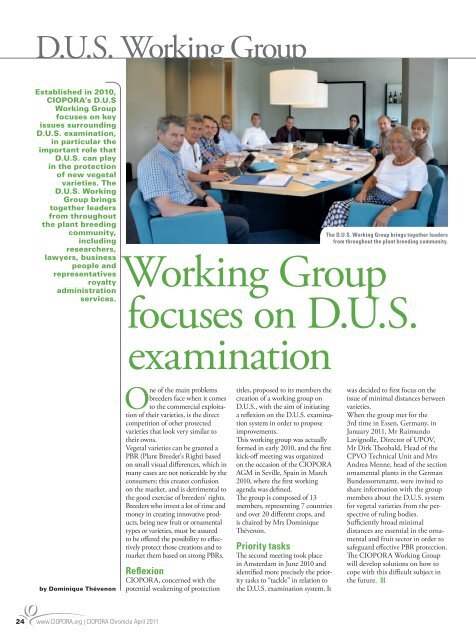2011 CIOPORA Chronicle - the 50th Anniversary Edition
CIOPORA annual magazine on Intellectual Property protection for plant innovations 2011. The magazine was produced in cooperation with FloraCulture International. Read in the 2011 CIOPORA Chronicle edition: - CIOPORA plays vital role in supporting the industry - PVR litigation on the rise - Plant Breeders´Right. Quo vadis? - China deploys national strategy for IPR - CIOPORA helps IP owners protect their rose varieties and much more...
CIOPORA annual magazine on Intellectual Property protection for plant innovations 2011. The magazine was produced in cooperation with FloraCulture International.
Read in the 2011 CIOPORA Chronicle edition:
- CIOPORA plays vital role in supporting the industry
- PVR litigation on the rise
- Plant Breeders´Right. Quo vadis?
- China deploys national strategy for IPR
- CIOPORA helps IP owners protect their rose varieties
and much more...
Create successful ePaper yourself
Turn your PDF publications into a flip-book with our unique Google optimized e-Paper software.
D.U.S. Working Group<br />
Established in 2010,<br />
<strong>CIOPORA</strong>’s D.U.S<br />
Working Group<br />
focuses on key<br />
issues surrounding<br />
D.U.S. examination,<br />
in particular <strong>the</strong><br />
important role that<br />
D.U.S. can play<br />
in <strong>the</strong> protection<br />
of new vegetal<br />
varieties. The<br />
D.U.S. Working<br />
Group brings<br />
toge<strong>the</strong>r leaders<br />
from throughout<br />
<strong>the</strong> plant breeding<br />
community,<br />
including<br />
researchers,<br />
lawyers, business<br />
people and<br />
representatives<br />
royalty<br />
administration<br />
services.<br />
Working<br />
The D.U.S. Working Group brings toge<strong>the</strong>r leaders<br />
from throughout <strong>the</strong> plant breeding community.<br />
Group<br />
focuses on D.U.S.<br />
examination<br />
by Dominique Thévenon<br />
One of <strong>the</strong> main problems<br />
breeders face when it comes<br />
to <strong>the</strong> commercial exploitation<br />
of <strong>the</strong>ir varieties, is <strong>the</strong> direct<br />
competition of o<strong>the</strong>r protected<br />
varieties that look very similar to<br />
<strong>the</strong>ir owns.<br />
Vegetal varieties can be granted a<br />
PBR (Plant Breeder's Right) based<br />
on small visual differences, which in<br />
many cases are not noticeable by <strong>the</strong><br />
consumers; this creates confusion<br />
on <strong>the</strong> market, and is detrimental to<br />
<strong>the</strong> good exercise of breeders’ rights.<br />
Breeders who invest a lot of time and<br />
money in creating innovative products,<br />
being new fruit or ornamental<br />
types or varieties, must be assured<br />
to be offered <strong>the</strong> possibility to effectively<br />
protect those creations and to<br />
market <strong>the</strong>m based on strong PBRs.<br />
Reflexion<br />
<strong>CIOPORA</strong>, concerned with <strong>the</strong><br />
potential weakening of protection<br />
titles, proposed to its members <strong>the</strong><br />
creation of a working group on<br />
D.U.S., with <strong>the</strong> aim of initiating<br />
a reflexion on <strong>the</strong> D.U.S. examination<br />
system in order to propose<br />
improvements.<br />
This working group was actually<br />
formed in early 2010, and <strong>the</strong> first<br />
kick-off meeting was organized<br />
on <strong>the</strong> occasion of <strong>the</strong> <strong>CIOPORA</strong><br />
AGM in Seville, Spain in March<br />
2010, where <strong>the</strong> first working<br />
agenda was defined.<br />
The group is composed of 13<br />
members, representing 7 countries<br />
and over 20 different crops, and<br />
is chaired by Mrs Dominique<br />
Thévenon.<br />
Priority tasks<br />
The second meeting took place<br />
in Amsterdam in June 2010 and<br />
identified more precisely <strong>the</strong> priority<br />
tasks to “tackle” in relation to<br />
<strong>the</strong> D.U.S. examination system. It<br />
was decided to first focus on <strong>the</strong><br />
issue of minimal distances between<br />
varieties.<br />
When <strong>the</strong> group met for <strong>the</strong><br />
3rd time in Essen, Germany, in<br />
January <strong>2011</strong>, Mr Raimundo<br />
Lavignolle, Director of UPOV,<br />
Mr Dirk Theobald, Head of <strong>the</strong><br />
CPVO Technical Unit and Mrs<br />
Andrea Menne, head of <strong>the</strong> section<br />
ornamental plants in <strong>the</strong> German<br />
Bundessortenamt, were invited to<br />
share information with <strong>the</strong> group<br />
members about <strong>the</strong> D.U.S. system<br />
for vegetal varieties from <strong>the</strong> perspective<br />
of ruling bodies.<br />
Sufficiently broad minimal<br />
distances are essential in <strong>the</strong> ornamental<br />
and fruit sector in order to<br />
safeguard effective PBR protection.<br />
The <strong>CIOPORA</strong> Working Group<br />
will develop solutions on how to<br />
cope with this difficult subject in<br />
<strong>the</strong> future. |||<br />
24 www.<strong>CIOPORA</strong>.org | <strong>CIOPORA</strong> <strong>Chronicle</strong> April <strong>2011</strong>









